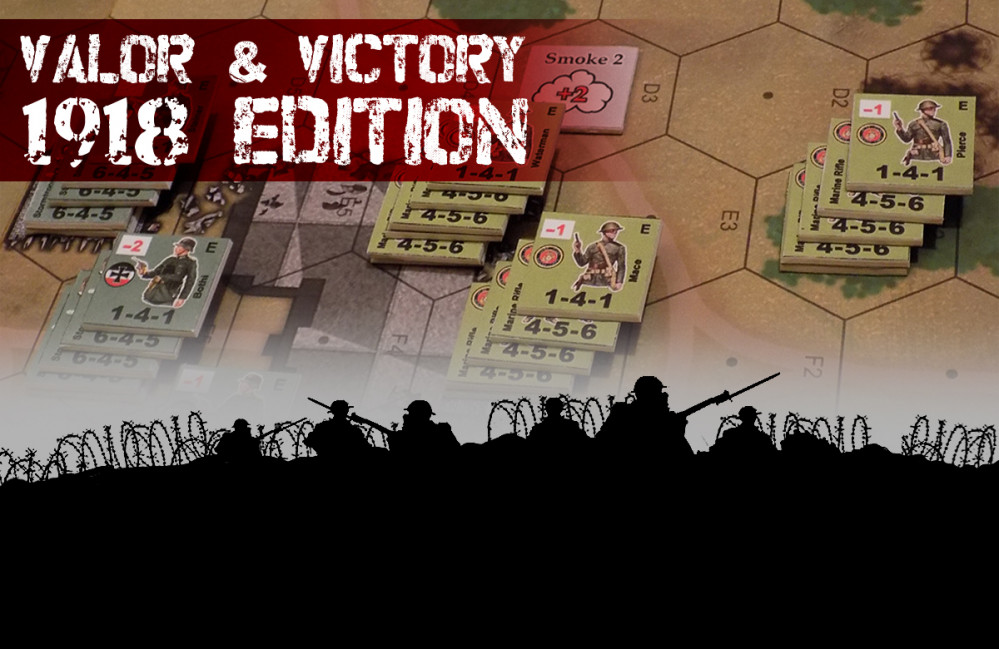
Valor & Victory - 1918 (German v. French Megagame)
Valor & Victory Megagame (P1)
All Not-So-Quiet on the Western Front
German Trench Assault vs. French
Blücher-Yorck Offensive
Chemin des Dames Sector, May 1918
Okay, it’s time to put these new French counters, trench boards, and German stosstruppen to the ultimate test. Just how big of a trench assault game can we actually do in Valor & Victory? Let’s find out!
So I set up all four trench boards I designed previously for Valor & Victory: 1918 Edition. As you can see below, the boards are designed to fit together in multiple configurations, and most games would not actually include all four boards. Really great platoon sized games could take place on one board, really. Most games would be two boards, “vertically” for a breakthrough penetration game, or “horizontally” for a broad attack game.
But here we have all four. I’ve also deployed, simply put, just about all of my French counters. So what we’re looking at here is:
French Forces:
Four rifle companies, each with (9) full squads, (2) officers, and (3) M1915 “Chauchat” machine rifle LMGs.
* Officers are mixed bag, two companies have (1) +2 officer and (1) +1 officer, the others have (2) +1s.
* Total: 288 men, 8 officers.
One weapons company, with (15) half-squad weapons crews, (6) M1914 Hotchkiss HMGs, (6) 3” Stokes mortars, and (3) Md58 T2 trench mortars, (2) +1 officers.
*Total: 60 men, 2 officers.
Grand French Total: 344 men, 10 officers.
Some closer pics of the French deployment. Note the M1914 Hotchkiss HMGs in frontal firing pits, each manned by a 2-5-2 half squad gun crew. Rifle platoons are also staged across this frontal line. Behind that are more platoons in a “secondary” trench line. Behind and intermingled with them are the 3”Stokes mortars – a British design that by the end of WW1 was actually being widely used by many Allied armies, French definitely included. Finally to the rear we have the larger Mod 58 T2 trench mortars in “reserve” or “artillery” trench lines.
Note the French are deployed in depth, and not bunched together. This is because they are expecting a Germans assault, and this will lead off with a large pre-planned artillery barrage. These fire missions very often “drift” off their intended targets, but if your group your forces too closely together, even enemy “misses” can drift right onto other friendly units. When expecting enemy artillery, the classic rule is to spread out. A
Also, the French want to keep some kind of reserve force for the second half of Turn 01 or even Turn 02, after the German stormtroopers have hit their forward line, taken hideous casualties from French opportunity fire and in the course of their initial assault into the French trenches. These weakened stormtrooper units can then be counter-assaulted by these French reserves, and perhaps turn the tide.
The Germans plan their initial bombardment. Again, those familiar with the Valor & Victory system will see there is already a pretty big change here. Normally you can only include these off-board support missions when you have a valid, unpinned spotter unit on the board with LOS on the target. Of course the Germans have no units on the board yet. So what gives?
Again, these are the new rules I’m trying out for 1918 Edition. These are-pre-planned artillery barrages. They can only happen on Turn 1, they cannot be “saved” for later, and hit only on a 1-3 result d6 roll instead of the usual 1-4 (i.e., they are less accurate). They represent the plastering that German batteries are putting down before the stosstruppen go in.
I should note that the German barrages for this scenario included in their order of battle are:
6 heavy barrages. (7.5cm+ howitzers).
6 light barrages (8.1cm+ mortars).
The German artillery whistles down in a horrific crescendo of screaming ordinance, slamming into the French line. You can see where some missions have drifted completely off their target. Others with the “explosion” margers have hit their targets and damage to French units in that hex. The large smoke marker designates where the fire missions has hit and completely obliterated all French units in that hex.
After the Germans roll to see whether each fire mission hits, the roll is then made of the Antipersonnel Firepower (APFP) table to see how much damage was done. The better the roll, the more casualty points are inflicted. Of course, heavy barrages tend to inflict more than light barrages (assuming they hit). For each unit stack hit, the French then have to “pay” the indicated casualty points, which they can do by eliminating squads, reducing squads half-squads, or pinning squads / half squads. Pinning squads keeps your men alive, but naturally you have to pin many more units to account for the same number of casualty points as a “killed” squad would pay for. Pinned units are also murderously vulnerable if they are assaulted in the enemy movement phase.
For this reason, the French pretty much bite the bullet here and choose to take the losses, losing fewer units rather than pinning many units. This is because a German assault is obviously coming, so the sergeants are screaming for their men to “hold their ground” and “keep eyes over the parapet” to meet the German assault already on the way.










































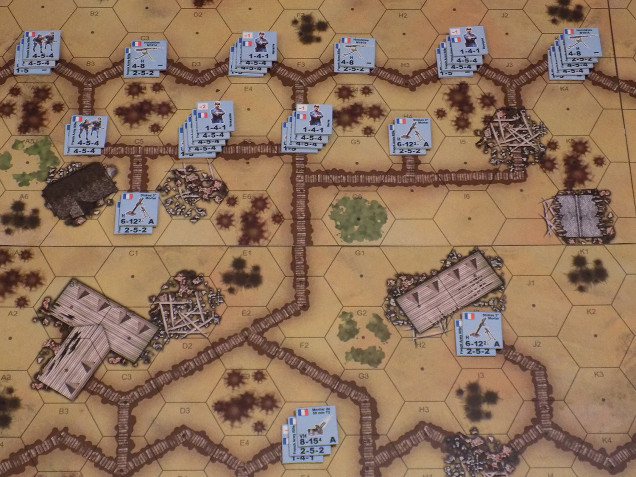
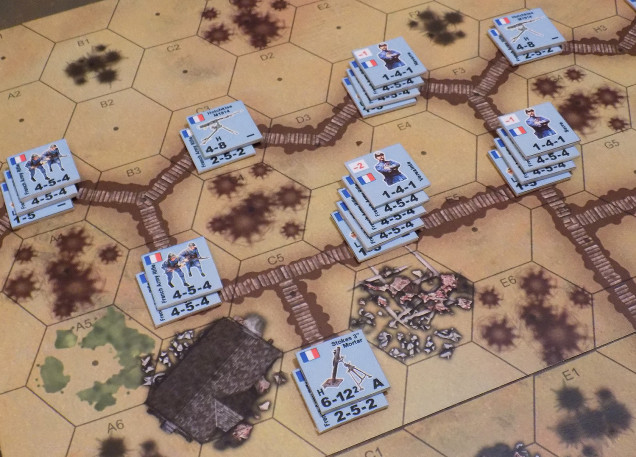
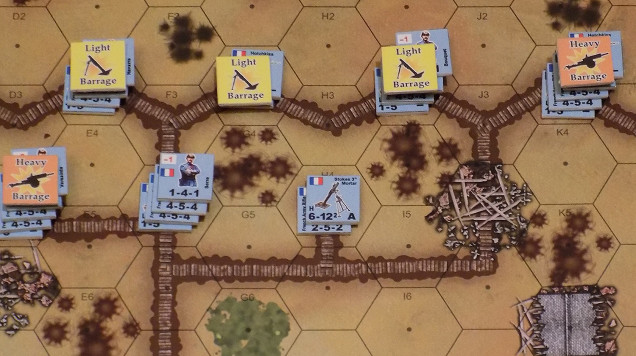
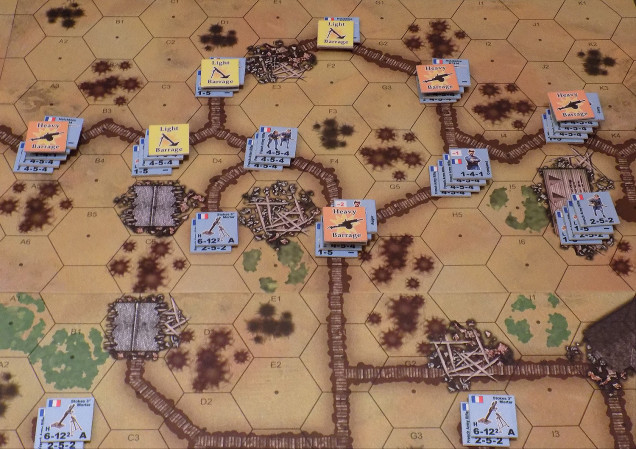
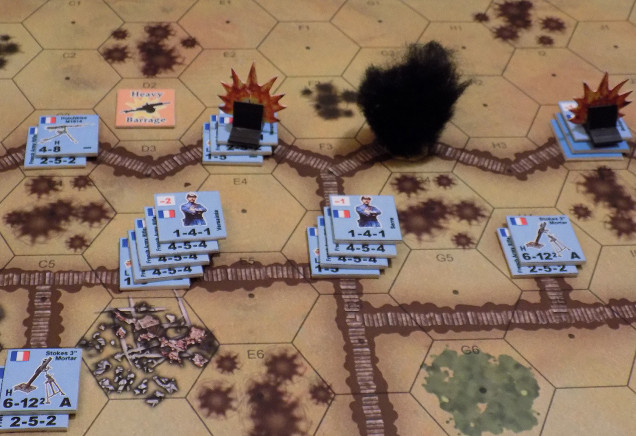
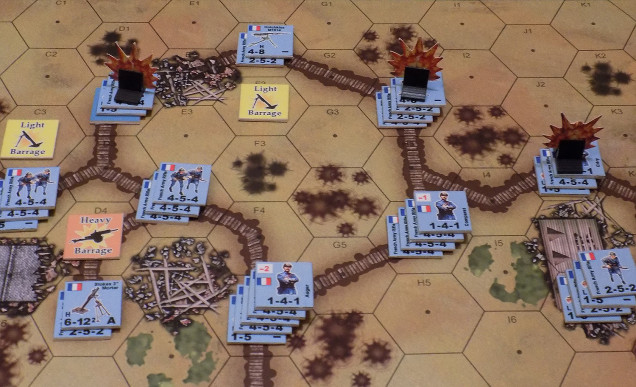

































Leave a Reply